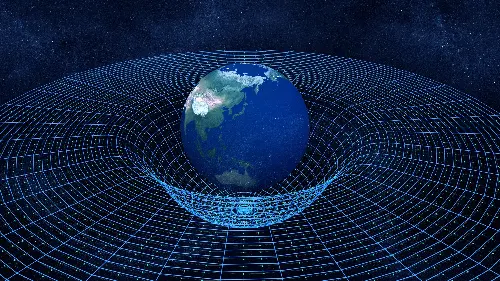
Albert Einstein's theory of general relativity—which explains gravity as the product of the distortion of space and time—may not be universally applicable.
This is the conclusion of physicists from the University of Geneva (UNIGE), Switzerland, and the Paul Sabatier University in Toulouse, France, who studied data from a survey mapping the shape of hundreds of millions of galaxies from various points of cosmic history.
When the team analyzed how the mass of these galaxies distorts space-time, they found a slight deviation from Einstein's predictions that they emerged between 5–6 million years ago.
This change coincides with an acceleration in the rate of expansion of the universe, and so may help shine a light on this puzzling phenomena.
Under Einstein's theory of general relativity, objects with mass distort space and time—much like how your mattress would deform if you placed a bowling ball on your bed.
This deformation of the fabric of the universe, the physicist proposed, is what we experience as gravity.
The space-time distortions around objects—like, for example, planets or stars—sit in their own little "gravitational wells".
And when light passes through these wells, it is bent as if passing through a magnifying glass, in a process known as gravitational lensing.
This aspect of general relativity was verified in 1919, four years after the concept was published, via experiments partly undertaken during a solar eclipse.
British astronomers Arthur Stanley Eddington and Frank Watson Dyson showed that the sun's gravity well deflected light from distant stars (which were visible while the sun was blocked out during the eclipse) exactly as general relativity predicted.
This was around twice that of the deflection anticipated by Newtonian physics, which did not account for the curvature of time as well as of space.
The question remains, however, as to whether Einstein's predictions remain correct on a universal scale.
In their study, the researchers used data from the Dark Energy Survey. This project is measuring the accelerating expansion of the universe, which is thought to be driven by a mysterious, invisible force dubbed dark energy.
"Until now, Dark Energy Survey data have been used to measure the distribution of matter in the Universe," said paper author and UNIGE cosmologist professor Camille Bonvin in a statement.
"In our study, we used this data to directly measure the distortion of time and space, enabling us to compare our findings with Einstein's predictions."
As light takes time to travel across space, looking far out into the distant universe is the same as looking back billions of years into time.
Taking advantage of this fact, the researchers analyzed 100 million galaxies from four different points in the universe's life span: 3.5, 5, 6 and 7 billion years ago—allowing them to explore how gravitational wells have changed over more than half of cosmic history.
"We discovered that in the distant past—6 and 7 billion years ago—the depth of the wells aligns well with Einstein's predictions," said paper author and astrophysicist professor Isaac Tutusaus of the Paul Sabatier University in a statement.
"However, closer to today—3.5 and 5 billion years ago—they are slightly shallower than predicted by Einstein."
It is during the second period, the researchers note, that the universe's expansion began to accelerate.
Accordingly it is possible that both mysteries have the same cause—specifically, that gravity may operate slightly differently at large scale than Einstein's theory predicted.
"Our results show that Einstein's predictions have an incompatibility of 3 sigma with measurements," said paper author and UNIGE theoretical physicist Nastassia Grimm in a statement.
What "3 sigma" means, Grimm explained, is that the difference is interesting and merits further investigation. However, she added, "this incompatibility is not large enough, at this stage, to invalidate Einstein's theory.
"For that to happen, we would need to reach a threshold of 5 sigma. It is therefore essential to have more precise measurements to confirm or refute these results, and to find out whether this theory remains valid in our universe at very large distances."
With their initial study complete, the team are getting ready to analyze data from the European Space Agency's Euclid space telescope, launched last year, which will provide more precise measurements of gravitational lensing.
Do you have a tip on a science story that Newsweek should be covering? Do you have a question about general relativity? Let us know via [email protected].
Reference
Tutusaus, I., Bonvin, C., & Grimm, N. (2024). Measurement of the Weyl potential evolution from the first three years of dark energy survey data. Nature Communications, 15(1), 9295. https://doi.org/10.1038/s41467-024-53363-6
Related Articles
- Scientists Discover Fast Radio Bursts Originate in Massive Galaxies
- First-ever Discovery of a 'Black Hole Triple' Amazes Astronomers
- How To See the ATLAS Comet Going Headless for Halloween
- Top Science Hacks for a Longer Life
